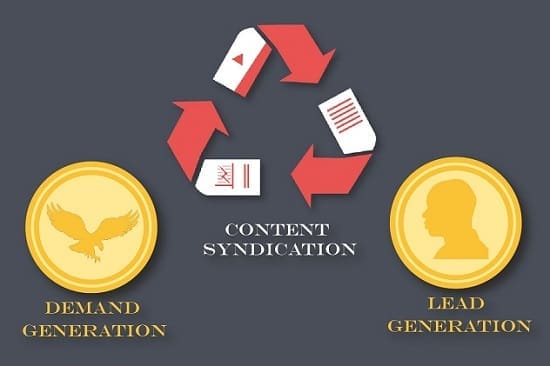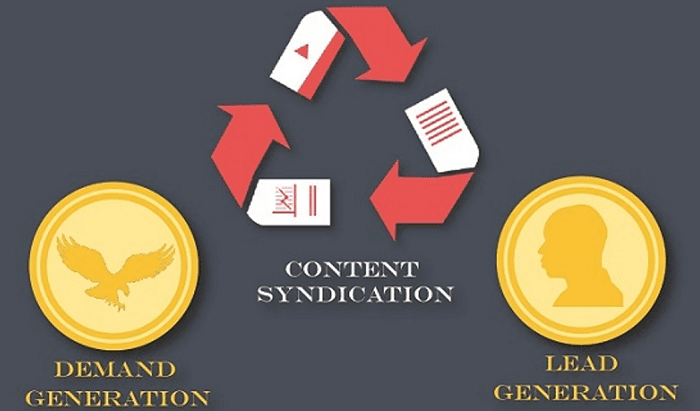Do you want your brand to be the first thing that pops into someone’s mind when they think of the services or products you offer?
Of course you do. You want potential customers to become customers, and for customers to stay that way.
But most of all, you want your business to grow and prosper.
And no, it doesn’t matter if you’re already an established business. If you’re not growing, you’re stagnating.
And if you’re stagnating, you risk withering to nonexistence.
So everyone listen up (startups, I’m talking to you) and get ready to learn how to improve demand and lead generation with our trusty marketing tactic, content syndication.

Two Sides of the Same Coin
What do the following have in common: peanut butter and jelly; cookies and milk; demand and lead generation?
5 points for the person in the back waving their hand wildly screaming, “THEY’RE ALL PERFECT FOR EACH OTHER!”
As much as I would love to go in depth into the perfect fit that are cookies and milk (seriously though, how can you not eat a cookie with milk?), our focus here is on demand and lead generation.
Incorrectly interchanged with each other by many, these two strategies are two halves of the whole that leads to growth.
Business growth (insert James Bond quip here).
Enough buildup, let’s get to it:
Demand Generation
Demand generation is pretty self-explanatory.
It’s all about generating demand for your product(s) or service(s), resulting in more sales and consequently, business growth.
It’s creating a need for what you offer in your potential customers’ minds.
You want to illustrate a problem they have, and if you happen to have a solution for said problem, then all the better (wink wink).
A quick stat: 63% of consumers requesting information about your business today will not make a purchase for at least three months.
Think of demand generation as a journey, an odyssey if you will.
Like most things in the ever-changing world of marketing, your journey start with an audience.
No matter what you think of your product, or its utility for that matter, there’s no way it can be relevant to every person on Earth.
So once you inform them of their need (demand for your service), they become your target audience by virtue of needing what you have.
These are the people who are more likely to be receptive to your message, and they are whom you will target.
Lead Generation
Out of demand generation comes lead generation. Well, sort of.
It doesn’t exactly come out of it.
In most cases, marketers focus on demand generation first, and then switch to lead generation once a demand has been established.
Kari Seas, founder of Seas Marketing, elaborates, “I would say in today’s marketing, demand generation is all about developing a pipeline for your sales team filled with leads most likely to convert into opportunities and eventually result in revenue.”
Similar to its counterpart, lead generation is quite self-explanatory.
You want to generate business leads by initiating consumer interest in your brand.
Therefore, the first part, demand generation, is about driving demand for your services.
And the second is about increasing interest in YOUR brand as the solution for their demands.
You create trust between your brand and audience, making them likely to come to you for help.
The goal is to capture their contact information and turn them into buyers. Got it? Good.
Let’s move to content.
Everyone with an ear tuned to marketing news knows that content is king.
Because of this fact, content marketing is one of the most commonly used lead generation strategies employed by brands all over the world.
With lead generation, your content shows your audience why you’re their best bet.
It hammers home the reasons why they should turn to you in their time of need.
Feel free to read through the following article for some trends on digital marketing that’ll help you out.
Demand and Lead Generation in Action
Sometimes the best way to learn something is through examples.
That’s exactly what we’re going to offer you to help boil this concept down.
Devenir: Benefits-Based Content
Devenir, a leader in HSA (health saving account) investments, wanted to increase demand for HSA investments (makes sense).
They decided that the best way to increase demand was to teach and explain the benefits of investing, so that’s what they did.
Devenir created three different sites with consumer solutions that ended up driving demand for the HSA investment market.
Because their audience was already on their site, they were well on their way to generating leads.
Allstate: Visual Content Featuring Mayhem
One more example, are you familiar with Mayhem?
No, not the word, the character (even though a character’s name is technically a word, but you know what I mean).
Mayhem is Allstate’s answer to demand and lead generation.
You’ve undoubtedly seen some of their commercials featuring Mayhem, but if you haven’t, no worries.
The commercials usually begin with Mayhem setting up a potentially dangerous situation as he explains what could happen.
Then BOOM, catastrophe strikes! An explosion, a crash, anything.
Fast forward a couple of seconds and the commercial ends with Mayhem telling the audience that with Allstate they will be “better protected from mayhem… like me.”
Now that’s what I call good demand and lead generation.
Content Syndication = Increased Demand and Lead Generation = Growth
Demand generation? Check.
Lead generation? Check.
Time to talk about content syndication. So, what is it?

Content syndication is what you do when you want to expand your audience.
It’s about forming partnerships with high-authority sites to increase your own reach.
In essence, you’re creating or repurposing content for external publication on a third-party site.
And of course, you will select a website with a larger audience and more traffic than yours, for greater exposure.
And when you pair content syndication with demand and lead generation, you get results. Let’s see how:
Combining Strategies
The foundation of any content syndication strategy is in the name: content.
Start with a blog that churns content within your niche.
Publish your own blog posts or articles on content syndication websites.
Guest post for similar websites in your industry.
Above all, your content should provide value.
Focus it on your audience’s problems, their questions and concerns.
Point them toward solutions that you provide.
Don’t sound promotional either.
Your purpose is to raise awareness and create demand for your services.
Insert a backlink to your site or product wherever it makes sense, but only as an example (this is how you can attract even more leads).
Keep a content calendar and schedule posts regularly to keep the flow going with your audience.
Don’t solely rely on text either.
Create images, videos and other visual content that’s easier to digest than a long blog post.
Dayna Rothman, Director of Content Marketing at EverString, similarly suggests, “Create diversity in your content. Your buyers have unique consumption wants and needs, so make sure your content comes in multiple formats.”
Infographics tend to do quite well in demand and lead generation.
Make some with stats pertinent to your audience’s problems and the solutions you offer.
In terms of your syndication partners, don’t go solely based on audience size.
It’s definitely important, yes, but higher priority should be devoted to their niche.
A website with a medium-sized audience (but still larger than yours) in your niche is better than a larger website that touches on but doesn’t exactly match your industry.
This all goes back to knowing your audience and what they care about.
Concluding Thoughts
Let’s wrap up what we learned today.
A content marketing plan for demand generation includes broadly distributing content to shape your audience’s demand around a specific service that you offer.
It also entails following through with lead generation that turns them into your customers.
Remember that demand is rather abstract.
You know it’s there, but can you measure it?
No, you can’t even ensure that your audience’s demand will translate to leads.
That’s where content syndication comes into the picture. It truly lets your marketing efforts take off.
In other words, your audience will expand, giving you more opportunities to drive awareness and interest into your services.
Then you pounce with content that points toward your brand as the optimal solution to their problems.
Featured Image provided by the author under his or her own license.
Disclaimer: The views and opinions stated in this post are that of the author, and Return On Now may or may not agree with any or all of the commentary.
Matthew Fritschle
Latest posts by Matthew Fritschle (see all)
- How to Improve Demand and Lead Generation with Content Syndication - April 25, 2017





